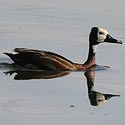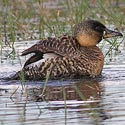|
Family: Dendrocygnidae (whistling ducks)
Life
> Eukaryotes >
Opisthokonta
> Metazoa (animals) >
Bilateria >
Deuterostomia > Chordata >
Craniata > Vertebrata (vertebrates) > Gnathostomata (jawed
vertebrates) > Teleostomi (teleost fish) > Osteichthyes (bony fish) > Class:
Sarcopterygii (lobe-finned
fish) > Stegocephalia (terrestrial
vertebrates) > Tetrapoda
(four-legged vertebrates) > Reptiliomorpha > Amniota >
Reptilia (reptiles) >
Romeriida > Diapsida > Archosauromorpha > Archosauria >
Dinosauria
(dinosaurs) > Saurischia > Theropoda (bipedal predatory dinosaurs) >
Coelurosauria > Maniraptora > Aves
(birds) > Order: Anseriformes
The majority of ducks fall
in the family Anatidae but the whistling
ducks are in a separate family, the Dendrocygnidae.
Species indigenous to southern Africa
|
Dendrocygna
bicolor (Fulvous duck)
This golden-brown coloured duck with long legs and neck
and greyish-black bill
is widely distributed worldwide, occurring in the Americas, Africa, Madagascar and
Asia. It is found mainly on large, shallow, inland water bodies with
aquatic plants round the perimeter. Eats pondweed (Potamogeton)
shoots, seeds of aquatic plants, and to a lesser extent, aquatic insects.
|
 |
|
Dendrocygna
viduata (White-faced duck)
This long-necked, dark brown duck with a white face
and greyish-black bill has a wide distribution ranging from tropical
America to Africa, Madagascar and the Comoro Islands. It is found mainly
on inland waters in savanna and grassland regions, and in southern Africa
is considered one of the most common ducks in these regions. It feeds both
in the water (mainly on aquatic vegetation and seeds), and on land (mainly
on grass seeds, including seeds from cultivated crops such as maize and
sorghum). Small amounts of invertebrates are also eaten (molluscs and
insects).
|
 |
|
Thalassornis
leuconotus (White-backed duck)
A
small diving duck with rufous and dark-brown barring, a black bill and a
diagnostic pale spot at the base of the bill, widely distributed in
sub-Saharan Africa on water bodies with emergent and floating plants.
Feeds almost exclusively on seeds of aquatic plants, which it obtains from
the muddy bottom by diving.
|
 |
|
